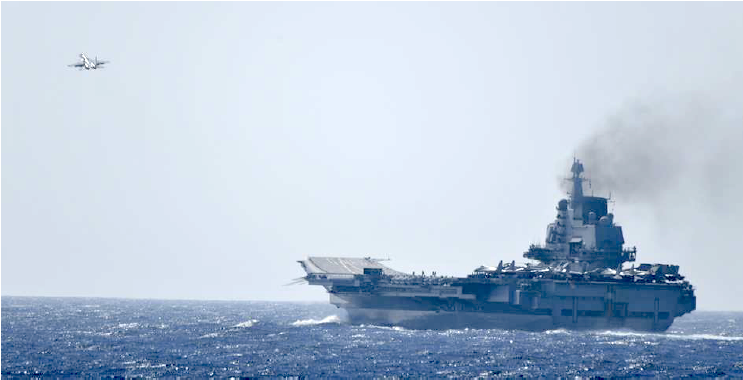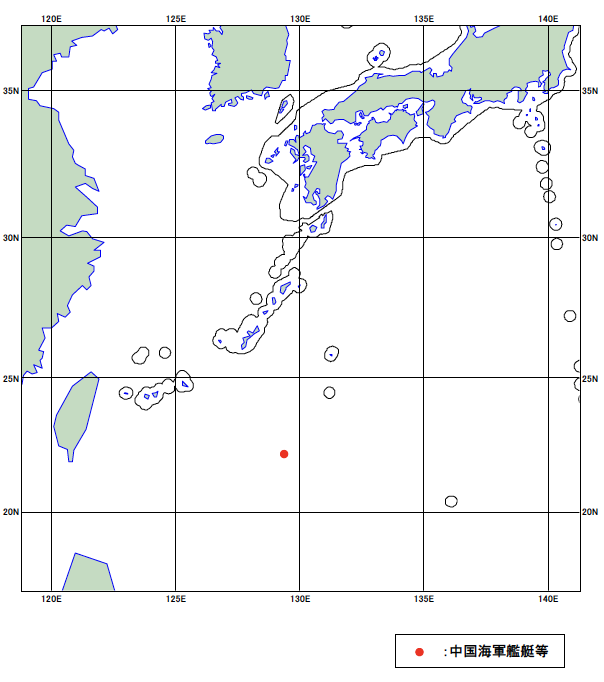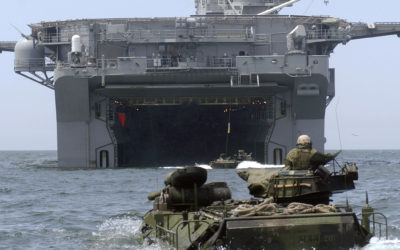On April 26, U.S. President Joe Biden welcomed South Korean President Yoon Suk-yeol to the White House for a summit meeting to celebrate the seventieth anniversary of the U.S.-South Korea alliance and open a new chapter for the next seventy years of expanded cooperation. Amid a substantial list of topics discussed by the two leaders, extended deterrence emerged as the top deliverable.
Chinese Liaoning Carrier Strike Group Now Operating in the Philippine Sea
Chinese Liaoning Carrier Strike Group Now Operating in the Philippine Sea
Chinese Liaoning Carrier Strike Group Now Operating in the Philippine Sea
The People’s Liberation Army Navy (PLAN) Liaoning Carrier Strike Group is now operating in the Philippine Sea, according to Japan’s Ministry of Defense.
Meanwhile, a PLAN survey ship entered Japan’s territorial waters on Monday and two Chinese H-6 bombers flew in and out of the Pacific Ocean on Monday afternoon, according to news releases from the Joint Staff Office (JSO) in the Ministry of Defense.
At 10 a.m. on Thursday, carrier CNS Liaoning (16), accompanied by cruiser CNS Anshan (103), destroyer CNS Chengdu (120), frigate CNS Zhaozhuang (542) and fast combat support ship CNS Hulunhu (901), was sighted sailing south 440 kilometers west of Fukue Island in the East China Sea, according to a Friday release from the JSO. At 12 p.m., cruiser CNS Wuxi (104) was sighted sailing southeast in an area 420 kilometers west of Fukue Island. Wuxi then joined the Liaoning CSG and all six ships sailed south together through the Miyako Strait into the Pacific Ocean on Friday.
Liaoning launched and recovered its helicopters while in the East China Sea, according to the release from Japan’s Ministry of Defense. Japan Maritime Self-Defense Force destroyer JS Kirisame (DD-104), together with a JMSDF P-1 Maritime Patrol Aircraft (MPA) of Fleet Air Wing 4 stationed at Naval Air Facility Atsugi, Honshu and a JMSDF P-3MPA of Fleet Air Wing 5 stationed at Naha Air Base, Okinawa, monitored the PLAN CSG.

A People’s Liberation Army Navy J-15 carrier fighter takes off from Chinese aircraft carrier Liaoning in the Philippine Sea. JSDF Photo
On Saturday at 11 a.m., Liaoning – along with Wuxi, Chengdu, Zhaozhuang and Hulunhu – was sighted in an area 260 kilometers southwest of Oki Daito Island, according to a Sunday news release from the Japanese government. Oki Daito is part of the Daito Islands group, which lies southeast of Okinawa, in the Philippine Sea. Liaoning conducted flight operations of its embarked fighters and helicopters from 11 a.m. to 5 p.m. Destroyer Kirisame continues to shadow the group and Japan Air Self-Defense Force fighter aircraft scrambled in response to the PLAN fighter jets taking off from Liaoning, according to the release.
The Liaoning CSG last deployed in the same area in May, when it conducted drills for over two weeks. Of the seven ships that accompanied Liaoning then, only Chengdu and Hulunhu are with the current CSG. Several other PLAN ships are also operating around the Pacific Ocean, with a surface action group comprising of cruiser CNS Lhasa (102), destroyer CNS Kaifeng (124) and replenishment ship CNS Taihu (889) transiting through the Osumi Strait into the Pacific Ocean on Wednesday. Meanwhile, on Thursday, destroyer CNS Taizhou (138) transited the Miyako Strait into the Pacific Ocean. Destroyer CNS Nanjing (155) and frigate CNS Anyang (599) transited into the Pacific Ocean via the Miyako Strait on Dec. 3.

Location of Liaoning in the Philippine Sea on Dec. 18, 2022. JSDF image
On Monday at 3:20 a.m., a PLAN hydrograph survey ship was sighted sailing westwards in an area 50 kilometers south-east of Tanegashima Island, part of the Osumi Islands group which lies south of the main island of Kyushu, according to a release issued by Japan’s Ministry of Defense. The hull number provided identified the ship as CNS Chen Jingrun (26). The PLAN ship entered Japan’s contiguous zone south of Tanegashima and at 6:50 a.m. It then entered Japan’s territorial waters south of Yakushima Island and left Japan’s territorial waters west of Kuchinoerabu Island at 10:30 a.m. and sailed southwest. A JMSDF P-1 MPA of Fleet Air Wing 1 based at JMSDF Kanoya Air Base, Kyushu monitored the PLAN ship, according to the release.
On Monday afternoon, two Chinese H-6 bombers flew in from the East China Sea and passed over the Miyako Strait into the Pacific Ocean before turning back at a point southeast of Oki Daito Island and transiting over the Miyako Strait into the East China Sea, according to a JSO news release issued Monday. JASDF fighters scrambled in response.
This article was republished from the U.S. Naval Institute News under a Creative Commons license to point warfighters and national security professionals to reputable and relevant war studies literature. Read the original article.

Dzirhan Mahadzir is a freelance defense journalist and analyst based in Kuala Lumpur Malaysia. Among the publications he has written for and currently writes for since 1998 includes Defence Review Asia, Jane’s Defence Weekly, Navy International, International Defence Review, Asian Defence Journal, Defence Helicopter, Asian Military Review and the Asia-Pacific Defence Reporter. Follow @DzirhanDefence
Related Articles
President Marcos Jr. Meets With President Biden—But the U.S. Position in Southeast Asia is Increasingly Shaky
Over a four-day visit to Washington, Philippine President Ferdinand Marcos Jr. has been welcomed to the White House and generally feted across Washington. With President Biden, Marcos Jr. (whose father was forced out of office in part through U.S. pressure, and whose family has little love for the United States) affirmed that the two countries are facing new challenges, and Biden said that “I couldn’t think of a better partner to have than [Marcos Jr.].”
The U.S. is about to blow up a fake warship in the South China Sea—but naval rivalry with Beijing is very real and growing
As part of a joint military exercise with the Philippines, the U.S. Navy is slated to sink a mock warship on April 26, 2023, in the South China Sea.
The live-fire drill is not a response to increased tensions with China over Taiwan, both the U.S. and the Philippines have stressed. But, either way, Beijing isn’t happy – responding by holding its own staged military event involving actual warships and fighter jets deployed around Taiwan, a self-governed island that Beijing claims as its own.



